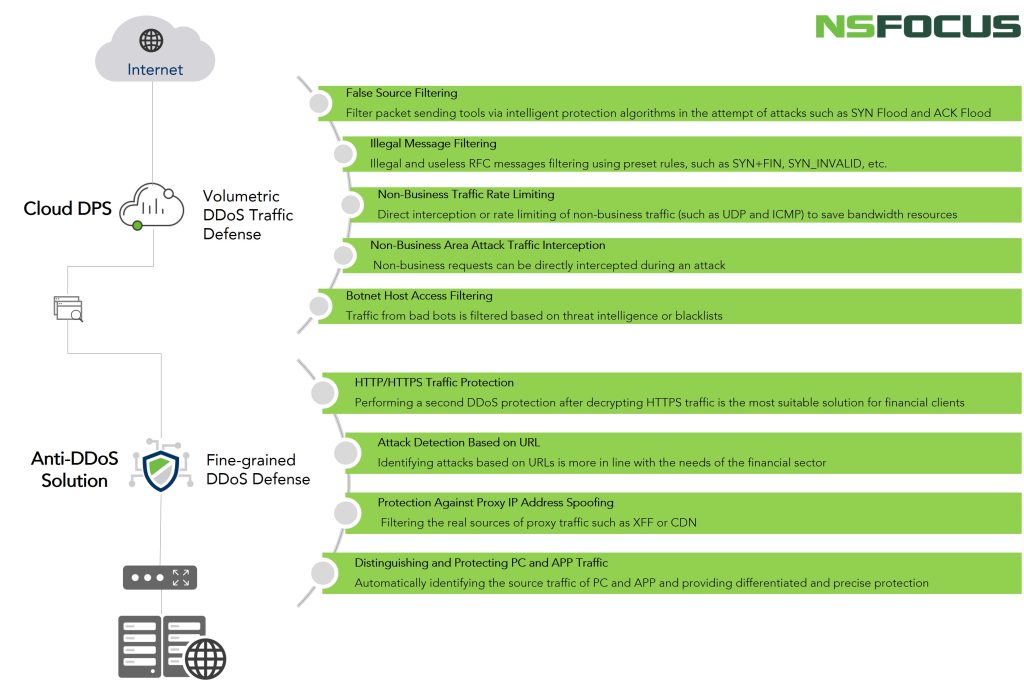With the digital transformation of the financial industry and the prevalence of online business, financial institutions inevitably face various cybersecurity threats, among which DDoS attacks are the most common and threatening. With the rise of Internet finance, banks, insurance companies, securities firms, and other financial institutions are gradually migrating their businesses to the cloud. This not only enables financial institutions to provide convenient services but also exposes them to increasingly severe DDoS attack challenges.
According to NSFOCUS’s 2023 Global DDoS Attack Landscape Report, the financial industry suffered DDoS attacks at a rate of 16.07% throughout the year 2023, ranking third after the Internet Technology and government agency sectors.
So why has the financial industry become a major target of DDoS attacks?
Financial institutions process large amounts of transaction data and fund flows. Once network services are interrupted, customers may be unable to perform normal operations such as transfers, payments, and inquiries, which could even lead to chain reactions. Attackers may use DDoS attacks to disrupt the operations of financial institutions, thereby affecting the market and extorting financial enterprises for illegitimate gains.
The financial industry involves a large amount of sensitive data, such as customer information and transaction records. Data leakage could result in significant financial losses for users and also provide opportunities for criminals to obtain benefits illegally. Therefore, financial institutions are targeted to obtain sensitive data or directly acquire money.
The financial industry typically uses APIs to connect applications and systems, enabling the implementation of functions required for financial industry-specific programs or other digital services on mobile devices. However, the special nature of API interfaces and the connections between components make APIs more vulnerable to attacks. Attackers can exploit vulnerabilities in API interfaces to launch DDoS attacks or other forms of network attacks, thereby paralyzing the operations of financial institutions.
.ai-rotate {position: relative;}
.ai-rotate-hidden {visibility: hidden;}
.ai-rotate-hidden-2 {position: absolute; top: 0; left: 0; width: 100%; height: 100%;}
.ai-list-data, .ai-ip-data, .ai-filter-check, .ai-fallback, .ai-list-block, .ai-list-block-ip, .ai-list-block-filter {visibility: hidden; position: absolute; width: 50%; height: 1px; top: -1000px; z-index: -9999; margin: 0px!important;}
.ai-list-data, .ai-ip-data, .ai-filter-check, .ai-fallback {min-width: 1px;}
How can we solve these problems?
1. Deploy On-premises DDoS Defenses (Anti-DDoS Solution)
On-premises Anti-DDoS devices can effectively protect against attacks on encryption protocols such as HTTPS through SSL offloading, while minimizing the risk of certificate leakage. At the same time, on-premises Anti-DDoS devices have short response times for protection, are not limited by Time-to-Mitigate in cloud-based traffic scrubbing, and have good defense effects against various new attacks such as carpet-bombing attacks, random subdomain attacks, pulse attacks, and reflection attacks. Moreover, defense configurations can be quickly fine-tuned based on changes in your business to achieve the best defense effects.
2. Combine with Cloud-based DDoS Protection Service (Cloud DPS)
Even if the on-premises DDoS defense is effective and strong, it cannot solve the problem of insufficient bandwidth. Therefore, after the completion of on-premises defense construction, the cloud-based DDoS protection service is recommended to cope with flood attacks that account for the highest proportion of large-scale DDoS attacks. The combination of on-premises DDoS devices and the cloud-based DDoS protection service, forms a defense system with the optimal traffic scrubbing efficiency and capacity to ensure the highest availability of your business services.

For more cybersecurity products and solutions, visit www.nsfocusglobal.com.
The post How Financial Institutions Can Protect Themselves from Modern DDoS Attacks appeared first on NSFOCUS, Inc., a global network and cyber security leader, protects enterprises and carriers from advanced cyber attacks..
*** This is a Security Bloggers Network syndicated blog from NSFOCUS, Inc., a global network and cyber security leader, protects enterprises and carriers from advanced cyber attacks. authored by NSFOCUS. Read the original post at: https://nsfocusglobal.com/how-financial-institutions-can-protect-themselves-from-modern-ddos-attacks/
This post was originally published on the 3rd party site mentioned in the title of this this site






